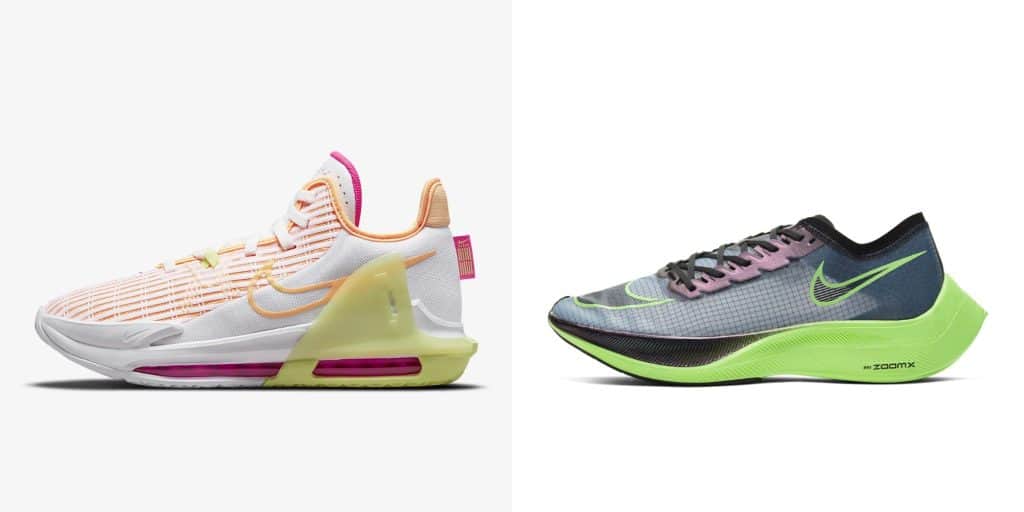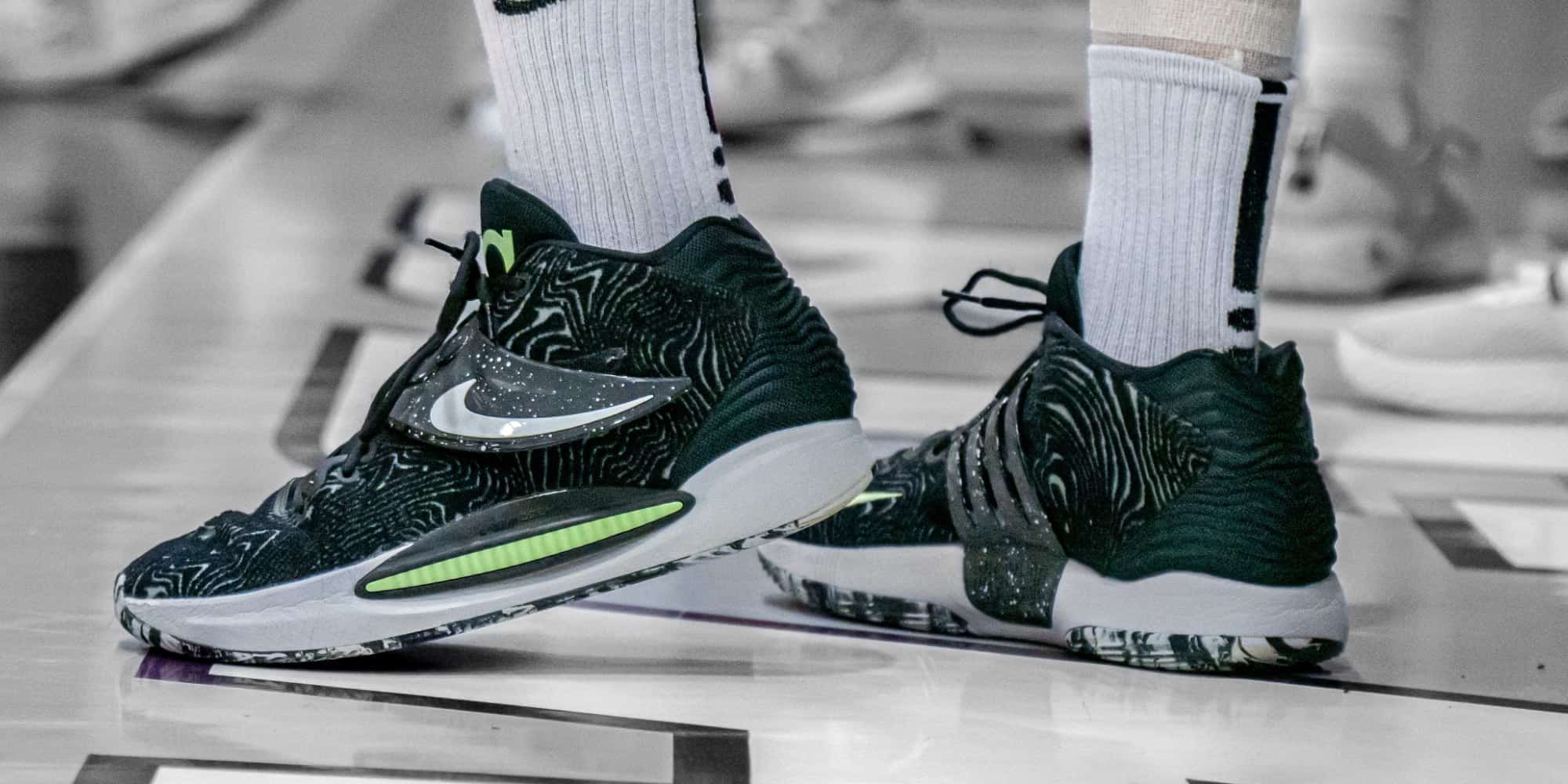The game of basketball naturally requires players to run up and down the court. Because of this, many people assume that wearing basketball shoes for running isn’t any different than wearing running shoes.
However, this is a wrong assumption. There are many differences between basketball shoes and running shoes, and of course, there are even different types of basketball and running shoes!
So in this article, we’ll look at what makes basketball shoes and running shoes unique, and with the differences in mind explain why basketball shoes are not suited for running. We’ll also take a look at the different types of basketball shoes, and find out the strengths and weaknesses of each type.
Basketball shoes are NOT a substitute for running shoes
Basketball shoes don’t make good running shoes because they are specially designed to provide extra support for harsh and unpredictable footwork—making them heavier and bulkier than proper running shoes.
In basketball, players rarely ever run in a straight line; instead, they sprint sideways and diagonally, making sudden stops and sprints in between. Therefore, basketball shoes need to be able to support rough and strong lateral movements with extra ankle protection. They also feature a wider and flat sole in order to give basketball players more stability.
When running, athletes usually run in a straight line, or at least in a constant direction. Therefore, running shoes are designed to generate more forward motion and offer more flexibility for minimal discomfort. As such, they’re lighter and provide more shock absorption around the heel and forefoot, which is where almost all the force is concentrated when running.

Features of Basketball Shoes
As we mentioned above, basketball shoes today are designed to support sudden short sprints in all directions. They usually have additional protection and shock absorption around the heels, as heels absorb much of the impact during jumping and strong stomps that are common on the basketball court.
Additionally, basketball shoes tend to have softer rubber soles as they are meant to be used indoors on the hardwood. Most notably, basketball shoes often come in high-top models that provide additional ankle support that is needed to endure the quick, sudden steps players usually take.
Features of Running Shoes
On the other hand, typical running shoes or sneakers are designed to support specifically the heel and forefoot areas. Given all of the body weight that falls in those areas plus the momentum of your body moving forward, they need to be able to absorb the entire shock from the strides.
They are also designed to be lighter, more flexible, and comfortable enough to endure long distances in them. Additionally, they tend to have rougher and harder soles because they are meant to be used on track or concrete and for trail running.
Of course, running shoes themselves are not all built the same. Some are good for shorter distances (sprints), while others are better suited for long-distance running and marathons. Some are designed for forefoot strike running, while others are designed for midfoot or heel strikers. For runners running on uneven terrain, trail running shoes are built with extra traction and added ankle support.
What happens if you run in basketball shoes?
If you run with basketball shoes, you run the risk – no pun intended – of getting tired early on because the shoes are heavier and do not provide the same type of forefoot and heel cushioning that running shoes do. Their flatter sole can also place extra strain on some foot areas and cause problems such as plantar fasciitis, an injury that causes severe pain at the bottom of the foot.
Basketball shoes should only be used for running if the distance isn’t too long. However, given its soles are created to provide extra grip on hardwood surfaces of indoor courts, running on concrete will wear them out much faster. So, you probably won’t want to ruin your indoor basketball shoes on hard surfaces outside.
What happens if you play basketball with running shoes?
The opposite case is even more dangerous. Playing basketball with running shoes leaves your foot exposed to easy ankle rolls and twists. This is because they are less rigid and leave your foot vulnerable to awkward motions and because they do not provide sufficient traction and width to move well sideways or laterally on the court.
Types of basketball shoes
Now that you know that it can be dangerous to wear basketball shoes when running, and even more dangerous to wear running shoes when playing basketball, you must also know there are three different basketball shoe types. Which one you use will want to use will depend on your playing position, playstyle, and level of comfort with your movements on the court.
High-top basketball shoes
These are the most common and well-known basketball shoes. They have the form of a boot and provide protection all the way up to the ankles. If you’re looking for maximum foot stability and maximum ankle safety, high-tops are the way to go.
Big men commonly use this type of shoe, but there are also some dribble-happy guards that opt for the extra ankle protection due to how much they move around. But many of the more nimble and agile guards don’t like high-tops because they feel their movement is limited and restricted by the extra ankle support. Either way, it depends on the playstyle of the player.
Mid-top basketball shoes
These are the middle ground between high-tops and low-tops, hence the mid-top name. Mid-tops give players that extra space for movement flexibility while still giving their ankles a good amount of support and protection. This is the primary reason why many NBA players are currently using mid-tops, with many new player signature shoes dropping in mid-top styles.
Low-top basketball shoes
Low-tops feature lower cuts, meaning they offer the least amount of padding around the ankle. They give players maximum freedom for movement on the court, although they do put you at increased risk of sustaining an ankle injury.
These lighter basketball shoes are the best type of basketball shoes for running, although they are still less than ideal.
Some modern-day guards like low-tops because they allow them enough flexibility to pull off extremely quick dribble moves. Low-top basketball sneakers are also the most common basketball shoe worn with casual outfits outside of basketball gyms.
Conclusion
Can you run in basketball shoes? Absolutely. However, it isn’t recommended for long distances or if you intend to use them consistently to run. Unlike most basketball shoes, running shoes are designed to provide optimal comfort and minimal strain over long distances. Besides any discomfort, running with basketball shoes could lead to serious foot or leg problems like plantar fasciitis and shin splints.

